
Develop your technical literacy
and creative design skills
For more information, visit:
www.mat.ucsb.edu/mad

Develop your technical literacy
and creative design skills
For more information, visit:
www.mat.ucsb.edu/mad

Abstract
I will present recent and ongoing work in the RE Touch Lab on emerging haptic and robotic technologies. Modern computing and AI operate at extraordinary speed over vast, high-dimensional data spaces, but their agency in the physical world is sharply constrained. Haptic and robotic systems provide this agency, but with constrained physical output bandwidth: they provide few degrees of freedom, and operate at far slower speeds than is feasible in computational domains. I will describe ongoing research in my group that is directed at alleviating such bottlenecks and at enabling computational systems with greater physical agency. A logical extension of these ideas: computationally authorable physical reality, an unmapped possibility whose territory and implications are compelling, if unclear.
Bio
Visell is Associate Professor of Mechanical Engineering and MAT Affiliate Faculty at the University of California, Santa Barbara. Visell directs the RE Touch Lab, where they pursue fundamental and applied research on the future of interactive technologies, with emphasis on haptics, robotics, and electronics, including emerging opportunities in human-computer interaction, sensorimotor augmentation, soft robotics, and interaction in virtual reality.
Dr. Visell’s research has been generously supported through multiple awards from the National Science Foundation and other government agencies, tech industry companies, and philanthropic foundations. He has published more than 75 scientific works, and served as editor and author of two books on VR, including "Human Walking in Virtual Environments" (Springer Verlag, 2013). His work has received four awards and more than a dozen award nominations at prominent academic conferences. Dr. Visell is a recipient of the National Science Foundation CAREER Award (2018), of a Hellman Family Foundation Faculty Fellowship (2017), and a Google Faculty Research Award (2016).
Dr. Visell spent more than five years in industry working at technology companies. He was the digital signal processing developer at Ableton from 2001 to 2003, where he wrote algorithms that have shaped music produced by artists ranging from The Roots to Deadmau5. Previously, he was a research scientist working on speech recognition at Vocal Point (now part of Nuance, makers of the Siri voice assistant). Prior to that, he designed auditory displays for underwater sonar at ARL, Austin, Texas. Dr. Visell later worked in interactive art, design, and robotics research at the University of the Arts Zurich, at FoAM, Belgium, at the Interaction Design Institute Ivrea, and at the art-architecture-technology group Zero-Th, which he co-founded in 2004. His creative works and activities have been presented at cultural venues including Ircam / Centre Pompidou (Paris, France), SIGGRAPH, Phaeno Science Center (Wolfsburg, Germany), La Gaité Lyrique (Paris), the Oboro Center (Montreal), and the Biennale of Design St. Etienne (France).
For more information about the MAT Seminar Series, go to:
seminar.mat.ucsb.edu.
Çağlarcan described his winning piece "Shadows" as an audiovisual transdisciplinary artwork that explores spiritual and social connections as his music overlays a selection of oil paintings by his brother, Güneş Çağlarcan, an accomplished painter and pianist.
For more information please read the article in the UCSB Current online magazine.

The project, Embodied Ink, was showcased at MAT's End of Year Show this past Spring.
Read the full paper here:
dl.acm.org/doi/10.1145/3746027.3756139
Video Presentation:
www.youtube.com/watch?v=08egiTo7yto

The fellowship allows Croskey to pursue a project that she is passionate about - enabling marginalized communities to secure their place in the future historical record, ensuring that emergent technologies, such as AI, elevate and empower these groups by reflecting their histories.
"Receiving the NSF GRFP amid our current political climate has given me an even greater sense of responsibility to pursue my research with full force,” Croskey said."

Read more in the UCSB College of Engineering Newsletter.
This year’s theme was “Myths and Legends”. Other artists receiving the award with Professor Kuchera-Morin were Mary Heebner, Gabriela Ruiz, Manjari Sharma, and Diana Thater.


The software creates personalized visuals and abstract art in an immersive landscape that is based on the memories of the crew members. The news articles highlight their work on a software pipeline that was being used at the St. Kliment Ohridski base on Livingston Island, Antarctica.
For more information, please see:
UCSB's The Current news magazine article:
New frontiers for well-being in Antarctica and isolated spaces.
Santa Barbara Independent article:
UC Santa Barbara Researchers Design Tools to Combat Isolation in Extreme Environments.


Iason Paterakis, Nefeli Manoudaki - AI driven visuals: Icescape

Iason Paterakis, Nefeli Manoudaki - AI driven visuals: Beach

Iason Paterakis, Nefeli Manoudaki - AI driven visuals: Plains
The title of the NSF award is Dynamic Control Systems for Manual-Computational Fabrication. Professor Jacobs was awarded the NSF Career Award to further her research in integrating skilled manual and material production with computational fabrication.
The CAREER Program offers the NSF's most prestigious awards in support of early-career faculty who have the potential to serve as academic role models in research and education and to lead advances in the mission of their department or organization.
Professor Jacobs thanks all of the amazing members the Expressive Computation Lab whose research contributed the intellectual foundations of this award.
UCSB News: Making Automation More Human Through Innovative Fabrication Tools
NSF link: Dynamic Control Systems for Manual-Computational Fabrication
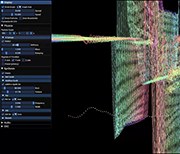
|

|
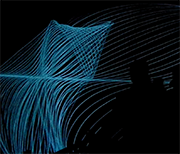
|
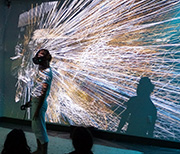
|
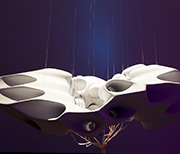
|
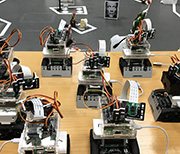
|
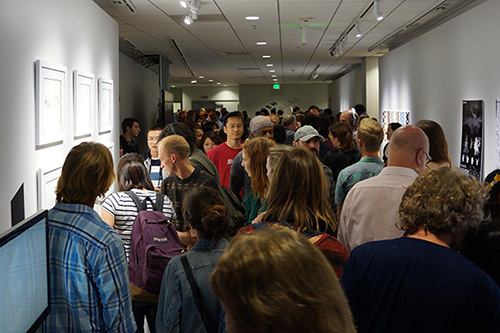
Media Arts and Technology (MAT) at UCSB is a transdisciplinary graduate program that fuses emergent media, computer science, engineering, electronic music and digital art research, practice, production, and theory. Created by faculty in both the College of Engineering and the College of Letters and Science, MAT offers an unparalleled opportunity for working at the frontiers of art, science, and technology, where new art forms are born and new expressive media are invented.
In MAT, we seek to define and to create the future of media art and media technology. Our research explores the limits of what is possible in technologically sophisticated art and media, both from an artistic and an engineering viewpoint. Combining art, science, engineering, and theory, MAT graduate studies provide students with a combination of critical and technical tools that prepare them for leadership roles in artistic, engineering, production/direction, educational, and research contexts.
The program offers Master of Science and Ph.D. degrees in Media Arts and Technology. MAT students may focus on an area of emphasis (multimedia engineering, electronic music and sound design, or visual and spatial arts), but all students should strive to transcend traditional disciplinary boundaries and work with other students and faculty in collaborative, multidisciplinary research projects and courses.